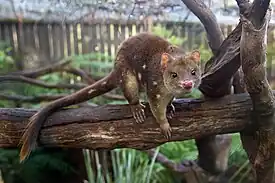Bonorong Wildlife Sanctuary
Bonorong Wildlife Sanctuary is a 9.7-hectare (24-acre) wildlife sanctuary located in Brighton, Tasmania, Australia. Dedicated to the rescue, rehabilitation, and preservation of native Australian animals, Bonorong actively participates in various conservation projects, contributes to breeding programs, research initiatives, and advocacy for the protection of Tasmania's wildlife.[2] The sanctuary works closely with government agencies, research institutions, and other conservation organisations to make a positive impact on native animal populations.[3][4] In 2015, the sanctuary received 66,000 visitors.[5]
| Bonorong Wildlife Sanctuary | |
|---|---|
 A spotted-tail quoll at Bonorong, 2012 | |
| Type | Wildlife sanctuary |
| Location | 593 Briggs Road Brighton, Tasmania Australia |
| Coordinates | 42°42′33.19″S 147°16′17.58″E |
| Area | 9.7 ha (24 acres) |
| Established | 1981 |
| Owned by | Greg Irons[1] |
| Open | 9am-5pm all year 9am-4pm (Christmas Day) |
| Parking | On-site |
| Public transit access | None |
| Website | www |
History
Bonorong Wildlife Sanctuary opened in 1981. Although the sanctuary name is derived from an Australian Aboriginal language meaning 'native companion', the origin of the nation is unknown.[6]
Friends of Bonorong
Friends of Bonorong is a registered charity associated with the sanctuary. Friends of Bonorong provides funding for urgent assistance to wildlife in crisis and to support long-term conservation through corporate donations, ongoing partnerships, and personal contributions.
Bonorong Wildlife Rescue
Opening in 2018, Bonorong Wildlife Rescue became Tasmania's first veterinary hospital dedicated to wildlife.[2][7]
Animals
On average, the sanctuary contains about 200 animals from 25 different species including eastern grey kangaroos, Tasmanian devils, wombats, sugar gliders, eastern quolls, sulphur-crested cockatoos, yellow-tailed black cockatoos, tawny frogmouths, echidnas and eastern bettongs.[5]
Access
Bonorong Wildlife Sanctuary is accessible via Briggs Road, Brighton with car parking on site. A private bus service called the Bonorong Shuttle departs from the Hobart CBD twice daily.[8]
References
- "Greg Irons - Wildlife rescue campaigner". Australian of the Year. Retrieved 2023-05-31.
- Shine, Rhiannon (2018-01-22). "Tasmanian wildlife gets its first dedicated medical service at Bonorong Wildlife Sanctuary". Australian Broadcasting Corporation. Retrieved 2023-05-31.
- Gwynn, Liz (2022-04-10). "Bonorong Wildlife Sanctuary helping to detect emerging diseases in wildlife across the country". Australian Broadcasting Corporation. Retrieved 2023-05-31.
- Glumac, Tamara; Oliver, Megan (2022-05-15). "Found an orphaned animal? What you should do next, according to expert wildlife carers". Australian Broadcasting Corporation. Retrieved 2023-05-31.
- Hudson, Sarah (2015-07-15). "Bonorong Wildlife Sanctuary is Tasmania's saviour of endangered species". Weekly Times. Retrieved 2023-05-31.
- "Greg Irons". Tom Wolff. Retrieved 2023-05-31.
- Kempton, Helen (2018-01-23). "New hospital at Bonorong Wildlife Sanctuary is just for the wild ones". The Mercury (Hobart). Retrieved 2023-05-31.
- "BONORONG WILDLIFE SANCTUARY DAILY SHUTTLE". Heart of Tasmania Tours. Retrieved 2023-05-31.
Sources
- Bonorong Park Wildlife Centre (Tas.) (2015). Empowering Wildlife Experiences: Bonorong Wildlife Sanctuary. Bonorong Wildlife Sanctuary. Retrieved 31 May 2023.
- Jungalwalla, Tanaz; Knott, Andrew (2019). Bonorong: The Critters of Bonorong Sanctuary (2nd ed.). ISBN 9780987180605.
- "10 Questions Greg Irons, Bonorong Wildlife Sanctuary director, 29.", The Australian (Magazine), New South Wales, Australia: News Limited: 6, 2013-02-16, ISSN 0313-4598